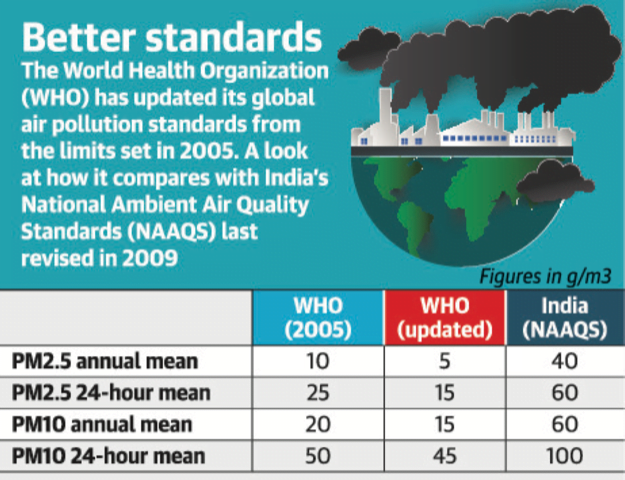UPSC Articles
WHO tightens global air quality norms
Part of: Prelims and GS III – Climate change
Context The World Health Organisation (WHO), in its first-ever update since 2005, has tightened global air pollution standards because it has been recognised in the past decade that the impact of air pollution on health is much more serious than earlier envisaged.
- Every year, exposure to air pollution is estimated to cause 7 million premature deaths and result in the loss of millions more healthy years of life.
New norms
- The upper limit of annual PM2.5 as per the 2005 standards is 10 microgram per cubic metre. That has now been revised to five microgram per cubic metre.
- The upper limit of PM10 is 20 microgram and has now been revised to 15.
- The 24-hour value has been revised from 50 to 45 microgram.
Impact on India
- The move does not have an immediate effect in India as the National Ambient Air Quality Standards (NAAQS) do not meet the WHO’s existing standards.
- The government has a dedicated National Clean Air Programme that aims for a 20% to 30% reduction in particulate matter concentrations by 2024 in 122 cities, keeping 2017 as the base year
What is National Ambient Air Quality Standards (NAAQS)?
- National Ambient Air Quality Standards are the standards for ambient air quality set by the Central Pollution Control Board (CPCB)
- The CPCB has been conferred this power by the Air (Prevention and Control of Pollution) Act, 1981.
- Ambient Air Quality Standards contains 12 pollutants
What is National Clean Air Programme (NCAP)?
- It was launched by the MoEFCC in January 2019.
- It is the first-ever effort in the country to frame a national framework for air quality management with a time-bound reduction target.
- It seeks to cut the concentration of coarse (PM10) and fine particles (PM2.5) by at least 20% in the next five years, with 2017 as the base year for comparison.
- The plan includes 102 non-attainment cities, across 23 states and Union territories, which were identified by the Central Pollution Control Board (CPCB) on the basis of their ambient air quality data between 2011 and 2015.
- Non-attainment cities: These are those that have fallen short of the National Ambient Air Quality Standards (NAAQS) for over five years.














